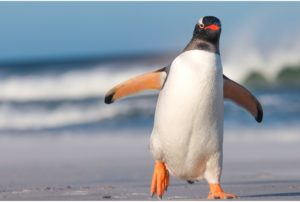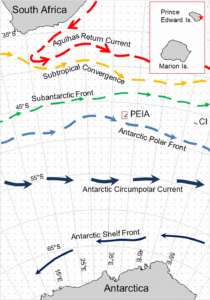Carpenter-Kling, T., et al. “Gentoo penguins as sentinels of climate change at the sub-Antarctic Prince Edward Archipelago, Southern Ocean.” Ecological Indicators 101 (2019): 163-172.
The newest indicator of climate change is here, and it is penguin puke? While it might seem a little far-fetched, researchers in the Southern Ocean are using the stomach contents of Gentoo penguins (Figure 1) to measure and predict climate change in the Antarctic Circle.
Why Gentoo Penguins?
Gentoo penguins are close to the top of the food web. They forage for a wide variety of prey in order to get all the nutrients they need to survive. Since they eat so many different organisms, the Gentoo penguins’ diet is a relatively new way to examine the effects of climate change in the Southern Ocean. Many environmental factors influence what the penguins eat, and changes in the environment are reflected in the penguins’ diet. IIn the Southern ocean, weather and oceanic conditions are controlled by the Antarctic Circumpolar Current (ACC). As climate change increases, it is predicted that the ACC will move southward (toward the South pole). As the ACC moves southward, the organisms at the base of the food web that thrive in its conditions will also move southward. Scientists wondered how a shift in the ACC might affect the Gentoo penguins, who feast on these organisms, and what does this tell us about the ACC?

Here’s how it works
Researchers have been monitoring the Gentoo penguins on Prince Edward Island (PEI) since the 1980’s. Over the past 20 years, the Gentoo penguin population on PEI has decreased by 50%. They hypothesized that the decline in the population was due to the southern shift of the ACC and thus the organisms the penguins eat. The scientists figured that if the penguins’ food was moving southward, then there would be a measurable shift in the PEI population’s diet. They also hypothesized that they would be able to see a marked difference in the organisms the penguins were eating in conjunction with the southward movement of the ACC.

In order to figure out what the penguins were eating, researchers had to get penguins to regurgitate their previous meals. The widely accepted method is using a pump to flush the penguins’ stomachs with warm water. While it might seem a little unconventional, this method has been vetted by the Commission for the Conservation of Antarctic Marine Living Resources and several studies have shown that the flushing has little to no effect on the subsequent feeding patterns of the penguins (SC-CAMLR 2003, Robertson et al. 1994).
After obtaining the stomach samples, researchers preserved them and took them back to the lab for analysis. The researchers tried to sample from penguins in a variety of life stages, from breeding to the time the penguins become “empty-nesters” or when the chicks are fully fledged. By taking samples at different life stages, the researchers were able to construct a diet timeline to assess the impact of ACC drift.
What does the puke tell us?
Researchers found that the diet of the Gentoo penguin has changed a lot over the past 30 years. The penguins have expanded their diet and seem to be eating more species that have traditionally been found outside of the PEI. The penguins’ favorite menu item, a type of benthic (or bottom-dwelling) shrimp, has become less available since the start of the study. The limited availability of these shrimp is linked to the population decline of the penguins, since a smaller shrimp population cannot support a large penguin population. The fact that penguins have become more adventurous eaters indicates that the currents associated with the ACC change as it moves south, bringing more pelagic (or open water) organisms to the PEI. Since these organisms are now more available, penguins have shifted to eating them rather than the benthic organisms they have traditionally eaten. Based on the results, the researchers argue that the diet of the penguins is strongly linked to the ACC and is a good way to predict or monitor its movement.
The movement of the ACC could bring changes at the ecosystem level for many regions in the Southern Ocean and some parts of Antarctica. With the effects of climate change increasing, the Gentoo penguin, and the contents of their diets, may become important “sentinels” or indicators oceanic conditions influenced by these effects.
If you want to know more about the Gentoo penguin, National Geographic has a Photo Ark page for them.
Sources:
Carpenter-Kling, T., et al. “Gentoo penguins as sentinels of climate change at the sub-Antarctic Prince Edward Archipelago, Southern Ocean.” Ecological Indicators 101 (2019): 163-172.
Kirkman SP, Yemane DG, Lamont T, Meÿer MA, Pistorius PA (2016) Foraging Behavior of Subantarctic Fur Seals Supports Efficiency of a Marine Reserve’s Design. PLoS ONE 11(5): e0152370. https://doi.org/10.1371/journal.pone.0152370
SC-CAMLR., 2003. CCAMLR Ecosystem Monitoring Program: Standard Methods for Monitoring Studies. CCAMLR, Hobart.
Robertson, Graham, et al. “Effects of the Water-Offloading Technique on Adélie Penguins Efectos De La Técnica De Anegar El Estómago Con Agua En Pygoscelis Adeliae).” Journal of Field Ornithology, vol. 65, no. 3, 1994, pp. 376–380. JSTOR, www.jstor.org/stable/4513954.
National Geographic Photo Ark. Gentoo Penguin. National Geographic. Accessed 29 June 2019. https://www.nationalgeographic.com/animals/birds/g/gentoo-penguin/
I recently graduated with a degree in Environmental Earth Science and Sustainability from Miami University of Ohio, and I recently started my MSc at the University of Victoria. While my undergraduate research focused on biogeochemical cycles in lakes and streams, I am excited to pursue my MSc in the El-Sabaawi Lab and explore how urbanization might impact fisheries. In my free time, I love to travel to somewhere off the beaten path, read fantasy novels, try new recipes, and plan my next trip to the ocean.
